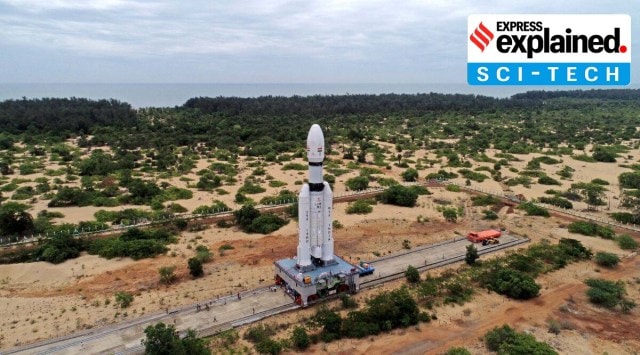Chandrayaan-3 mission: What went wrong with Chandrayaan-2?
Launched on July 22, 2019, the Chandrayaan-2 mission’s lander and rover were supposed to make a soft landing on the Moon on September 7. However, according to Isro Chairman S Somanath, three mistakes led to their crash on the lunar surface. What went wrong?
 The LVM-3 rocket and Chandrayaan-3 spacecraft at the launchpad in Sriharikota. (Photo: Twitter/@isro)
The LVM-3 rocket and Chandrayaan-3 spacecraft at the launchpad in Sriharikota. (Photo: Twitter/@isro) Launched from the Satish Dhawan Space Centre in Sriharikota on Friday (July 14) at 2:35 pm, the Chandrayaan-3 is India’s third lunar mission and second attempt to make a soft landing on the Moon. The mission is expected to reach the lunar orbit a month after its launch, and its lander and rover are likely to land on the lunar surface on August 23.
The Chandrayaan-3’s launch has come almost four years after the partial failure of the Chandrayaan-2, sent to space on July 22, 2019, whose lander, Vikram, and rover, Pragyaan, crashed on the Moon’s surface during the early hours of September 7.
What happened on the day of landing of Vikram?
The Indian Space Research Organisation (ISRO) lost contact with Vikram on the day of landing when it was barely 335 metres (0.335 km) from the surface of the Moon. The initial data from the space agency’s Telemetry Tracking and Command Centre suggested that the failure occurred in the “Fine braking phase” in the final part of Vikram’s journey (an altitude of 5 km to 400 m), which kicked in when the lander was 5 km from the lunar surface.
The giant screens installed at the centre showed that the green line, which represented the lander, began deviating from the time its altitude was just above 2 km, and continued to deviate before stopping at a point that was clearly below 1 km altitude, and somewhere near or below 500m.
At that time, the module was still moving with a vertical velocity of 59 metres per sec (or 212 km/hr) and a horizontal velocity of 48.1 m/sec (or 173 km/hr). The lander was at that point around 1.09 km from its designated landing spot on the Moon.
According to the plan, Vikram was supposed to lose most of its velocity by the time it was 400m from the lunar surface, and should have been hovering above the intended landing site — set to make a soft vertical descent at “walking pace”. But due to its high velocity, it crashed on the Moon’s surface.
Why did the Chandrayaan-2’s lander fail to soft-land on the Moon?
Speaking to the media on Monday (June 10), Isro Chairman S Somanath pointed out three mistakes that led to the hard landing of Vikram.
“The primary issues were, one, we had five engines which were used to give the reduction of the velocity, which is called the retardation. These engines developed higher thrust than what was expected,” Somanath told the reporters, according to a PTI report. He explained that the extra thrust led to the accumulation of errors, which, in turn, compromised the stability of the lander during the “camera coasting phase’’ for the soft landing.
This is where the second problem occurred. “All the errors got accumulated, which was on the higher side than what we had expected. The craft had to make very fast turns. When it started to turn very fast, its ability to turn was limited by the software because we never expected such high rates to come,” Somanath added.
The third problem emerged when the lander, despite being close to the surface, increased its velocity as the landing site was quite far away. Somanath said this partly happened because the landing spot was quite a small patch of 500 m x 500 m.
“In a nutshell, the problem in Chandrayaan-2 was that the ability to handle parameter dispersion was very limited,” he said, according to the PTI report.
(With inputs from PTI)
- 01
- 02
- 03
- 04
- 05






































